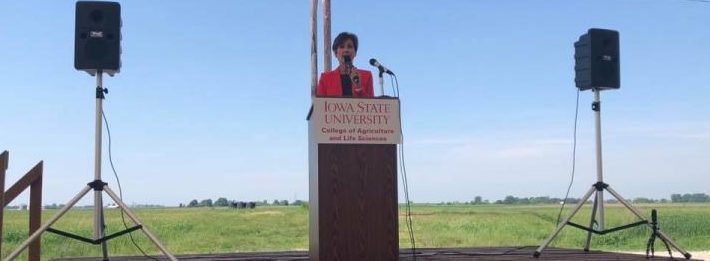May 29, 2018, BOONE – The Iowa Nutrient Reduction Strategy is a science and technology-based framework to assess and reduce nutrient loss from both point sources and nonpoint sources in Iowa. Point sources include municipal and industrial wastewater treatment plants, etc. Nonpoint sources include stormwater runoff from both urban and agricultural landscapes.
The Strategy was finalized on May 29, 2013. In the five years since there has been significant work by farmers, landowners, communities, businesses, stakeholders, and partners to help improve water quality in Iowa.
“The Iowa Nutrient Reduction Strategy was a groundbreaking effort using science and technology to look at the issue of water quality and identify what practices are needed on the landscape to achieve our water quality goals. Iowa has continued to lead the way in implementing the practices outlined in the Strategy and now committing long-term funding to supporting the effort. I’m excited by the progress that has been made and the foundation that has been laid for future success,” said Mike Naig, Iowa Secretary of Agriculture.
A broad cross-section of Iowa political, agricultural and community leaders gathered at the Iowa State University BioCentury Research Farm today. They gather to celebrate the achievements that have taken place since the Strategy was finalized and share a vision for the next five years and beyond.
Progress
The foundation of the Strategy is that changes in the landscape are needed to meet the water quality goals outlined in the Strategy. Everyone has a role to play in this effort. Farmers, businesses, communities, homeowners and industrial sites can all make changes to prevent nutrient runoff and protect our state’s water quality.
“Legislators have funded it, cities, industries, and farmers are implementing it and the principals that formed the Nutrient Reduction Strategy continue to refine and improve it,” said John Lawrence, Iowa State University’s Vice President of Extension and Outreach, who led the development of the strategy’s scientific assessment team when he was associate dean with ISU’s College of Agriculture and Life Sciences.
“We’re now seeing wastewater treatment plants being planned and built with nutrient removal technology, we’re seeing operators optimize treatment to meet nutrient reduction goals, and we’re seeing cities invest in conservation practices in their watersheds,” said Bruce Trautman, Acting Director of the Iowa DNR.
Examples of progress include:
- $420 million in private and public sector funding for water quality efforts in 2017, an increase of $32 million compared to the previous year.
- More than 250 partner organizations are participating in the 65 water quality demonstration projects underway across the state. These partners will provide $37.7 million to go with the $23.4 million in state funding going to these projects.
- 760,000 acres of cover crops were planted in Iowa in 2017, up 22 percent from the year before. That compares to less than 10,000 acres planted with cost share in 2009.
- Over the past 5 years, 8,000 farmers, including nearly 4,600 first-time users, signed up to use a water quality focused practice. These farmers invested more than $17 million to try cover crops, no-till, strip-till or a nitrification inhibitor on their land.
- The Iowa Nutrient Research Center at Iowa State University, created by the Legislature in 2013, has provided over $7 million to fund 60 competitive grants focused on evaluating the performance of current conservation practices and developing new approaches to reducing nutrient loss from agricultural landscapes. Center-supported research focuses on management practices, land-use practices, edge-of-field practices and other water quality areas.
- Of the 154 municipal wastewater plants and industrial facilities required to assess their nutrient removal capacity, 125 have been issued new permits. Of those, 83 have also submitted feasibility studies on potential technology improvements.
- Twelve cities and seven industries have met the NRS point source reductions targets for nitrogen removal (66 percent removal). Five cities and three industries have met the NRS point source reduction targets for phosphorus removal (75 percent removal).
- 43 municipal and industrial wastewater treatment plants have committed to construct upgrades to remove phosphorus and nitrogen.
- Water monitoring systems have improved by utilizing “real-time” sensor technology for nitrogen and turbidity that allows for a much more accurate and precise accounting of statewide nutrient loads.
Logic Model Frame Work
More information about the work that has taken place can be found in the Iowa Nutrient Reduction Strategy Annual Progress Report. The report provides progress updates on point source and nonpoint source efforts to reduce nitrogen and phosphorus loads leaving the state.
The Report follows the “logic model” framework that identifies measurable indicators of desirable change that can be quantified and represents a progression toward the goals of the Strategy. The full report is available at http://www.nutrientstrategy.iastate.edu/documents.
Next 5 years and beyond
The Iowa Legislature passed and the Governor signed into law legislation that will provide more than $250 million for water quality efforts in Iowa over the next 12 years. This significant, long-term funding source will allow Iowa to build on the strong foundation that has been established and expand the collaborative, science-based efforts underway across the state
This additional funding will support efforts to reach out and add new partners to support the work underway across the state. Long-term, predictable funding makes it easier to leverage funds and attract additional investments from partners because they can see real evidence of the state’s commitment to working on water quality.
While significant work has taken place over the past five years within small, targeted watersheds, the long-term funding allows work on next phase of moving to larger, watershed scale implementation projects. This scaling up will follow a targeted approach that focuses on nine large priority watersheds that have been identified by the Iowa Water Resources Coordinating Council.
The Right Path
“We are on the right path and continuing to work collaboratively and with science as our guide, we will continue to make significant water quality improvements in our state,” Naig said.
In upcoming years, research will continue through the Iowa Nutrient Research Center to provide the scientific support necessary to meet the Strategy’s goals and to connect research results to farmers, landowners, and stakeholders. Scientists will continue working to improve newer technologies and practices such as bioreactors, saturated buffers, prairie strips, drainage water recycling and cover crops — some of which have shown the potential to dramatically reduce loss of nutrients to Iowa waters.
More information about the Strategy can be found at www.NutrientStrategy.iastate.edu.
-30-
Contacts:
Dustin VandeHoef – IDALS
515-281-3375 or [email protected]
Alex Murphy – DNR
515-725-8219 or [email protected]
Brian Meyer – Iowa State University
(515) 294-0706 or [email protected]



